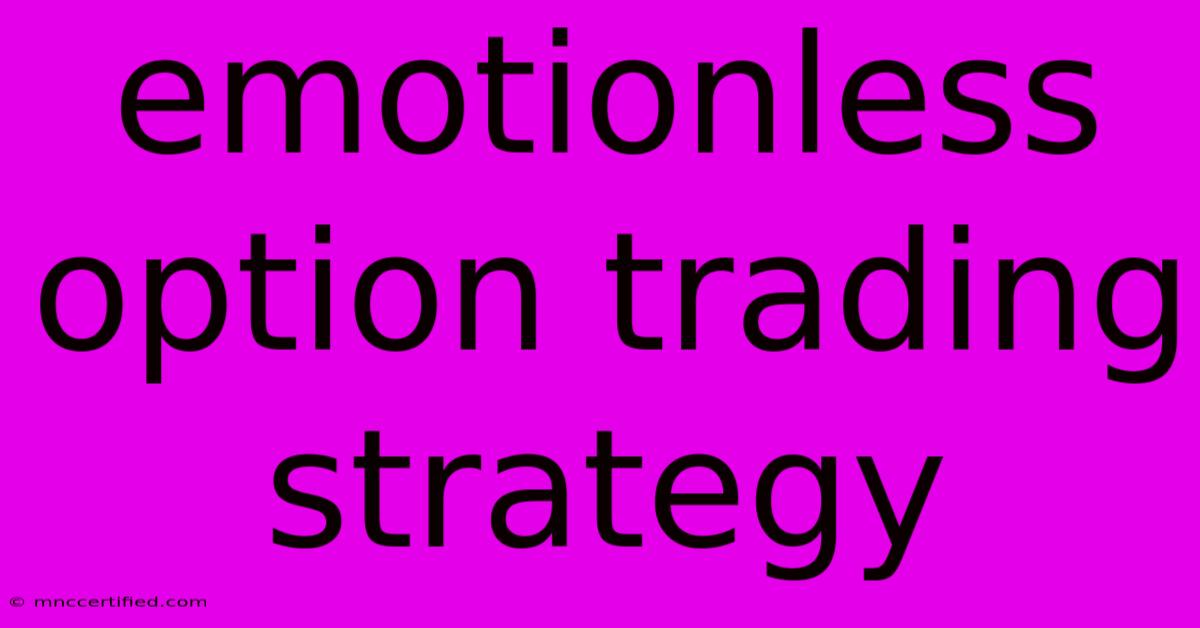Emotionless Option Trading Strategy

Table of Contents
The Emotionless Option Trading Strategy: A Guide to Navigating Market Volatility
In the dynamic and often unpredictable world of trading, emotions can be your biggest enemy. Fear, greed, and impulsiveness can lead to poor decision-making, resulting in significant losses. This is where the emotionless option trading strategy comes into play. This strategy emphasizes discipline, data-driven analysis, and a detached approach to market fluctuations.
Understanding the Emotional Side of Trading
Before delving into the strategy, it's crucial to acknowledge the emotional impact of trading. When faced with market volatility, traders often experience:
- Fear of missing out (FOMO): The urge to jump into a trade, fearing that you'll miss out on potential gains.
- Greed: Holding onto losing positions, hoping for a reversal, or chasing after quick profits.
- Overconfidence: Ignoring risk management and believing that you can predict market movements accurately.
These emotions can lead to reckless trading decisions, jeopardizing your capital and your overall trading strategy.
The Pillars of Emotionless Option Trading
The emotionless option trading strategy revolves around several core principles:
1. Objective Analysis:
- Focus on technical and fundamental data: Base your trading decisions on data, not hunches. Analyze charts, study market trends, and understand company fundamentals.
- Utilize indicators and strategies: Employ proven indicators like moving averages, MACD, and Bollinger Bands to identify potential opportunities.
- Develop a trading plan: Define your entry and exit points, risk tolerance, and stop-loss levels before entering a trade.
2. Discipline and Patience:
- Stick to your plan: Don't deviate from your predetermined strategy. Emotions can lead you to abandon your plan, leading to impulsive decisions.
- Accept losses: Understand that losses are part of trading. Focus on managing risk and learning from mistakes.
- Be patient: Don't expect to get rich quickly. Patience and discipline are key to long-term success in option trading.
3. Risk Management:
- Define your risk tolerance: Determine how much you are comfortable losing on each trade.
- Use stop-loss orders: Set limits on your potential losses to protect your capital.
- Diversify your portfolio: Don't put all your eggs in one basket. Spread your investments across different options strategies and assets.
4. Emotional Detachment:
- Recognize the emotional impact of trading: Understand that your emotions can cloud your judgment.
- Develop mental resilience: Learn to manage stress and maintain a calm composure during market volatility.
- Seek professional help if needed: Consider working with a therapist or counselor to manage emotional triggers related to trading.
Putting the Strategy into Practice
Here are some practical tips to implement the emotionless option trading strategy:
- Trade with a demo account: Practice your strategy and refine your skills without risking real capital.
- Keep a trading journal: Record your trades, emotions, and lessons learned. This will help you identify patterns and improve your decision-making.
- Seek mentorship: Learn from experienced traders and mentors who can guide you on your journey.
- Focus on long-term goals: Don't get caught up in short-term market fluctuations. Instead, focus on your overall financial goals.
Conclusion: Mastering Emotions for Success
The emotionless option trading strategy is a powerful tool for navigating the complexities of the market. By prioritizing discipline, objective analysis, risk management, and emotional detachment, you can improve your trading decisions and increase your chances of success. Remember, trading is a marathon, not a sprint. Cultivate patience, learn from your mistakes, and build a solid foundation for long-term success.

Thank you for visiting our website wich cover about Emotionless Option Trading Strategy. We hope the information provided has been useful to you. Feel free to contact us if you have any questions or need further assistance. See you next time and dont miss to bookmark.
Featured Posts
-
Cynthia Erivos Unwavering Voice
Nov 15, 2024
-
Commanders Eagles Tnf Key Matchups And Predictions
Nov 15, 2024
-
Wicked Stars Erivo De Bose On Collaboration
Nov 15, 2024
-
Jalen Hurts Brotherly Shove Td For Eagles
Nov 15, 2024
-
Live Latin Grammys 2024 Updates
Nov 15, 2024